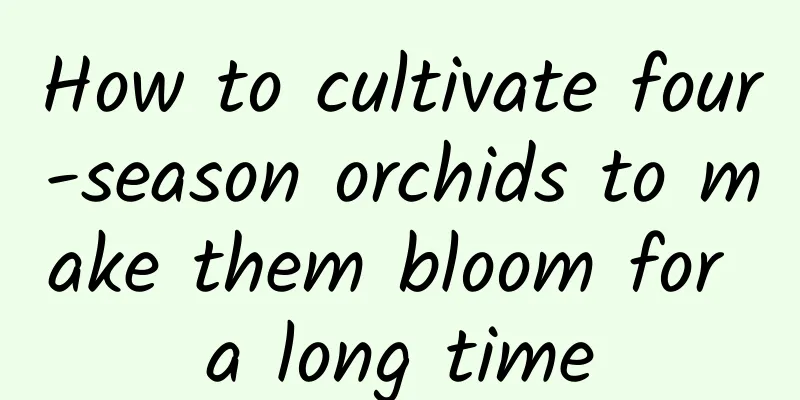How to cultivate four-season orchids to make them bloom for a long time

Four Seasons Orchid Growing ConditionsFour-season orchids prefer warm and humid mountainous areas. They are suitable for growth in an annual average temperature between 15-23℃. In summer, the temperature is high and needs to be cooled by shading. They generally grow in the shade and wetlands of forests below 1,500 meters above sea level. The sunny south-facing foggy places are good environments for plant growth. How to grow four-season orchidsIf we want the four-season orchids we grow to bloom for a long time, then when planting them, we need to use purple clay pots and loose, well-drained soil. Do not water them excessively. Generally, water them once every 2-3 days. Also, give them sufficient sunlight. In addition, after finding pests, spray them with carbendazim or omethoate emulsion in time. Watering orchids in four seasonsFour-season orchids are generally watered every 2-3 days. It is best to water them at noon in winter and in the morning or evening in summer. Do not water them at noon in summer. Fertilizing Four Seasons OrchidsFour-season orchids are best fertilized in spring and autumn. Fertilization is not suitable in high and low temperature seasons. Applying bud-promoting fertilizer in spring has a greater impact on the growth throughout the year. Applying bud-promoting and seedling-strengthening fertilizer in autumn should pay attention to the concentration when applying fertilizer, and the water quality should be free of impurities when diluting. Four Seasons Orchid Pest ControlFour-season orchids are often harmed by anthracnose, black spot, scale insects and other diseases. For diseases, spray them with carbendazim wettable powder, and for pests, spray them with omethoate emulsifiable concentrate. How to grow orchids at home in four seasons1. Potting soil: Fill the bottom of the four-season orchid pot with small stones or broken tiles to one-third of the pot height. Use burnt soil as the plant material and knock it into granules. At the same time, add a few cooked soybeans to the plant material as high-quality base fertilizer. 2. Light: The suitable shade degree for four-season orchids is between 65% and 75%. They should be placed near the window on the indoor table, but not directly exposed to the sun to prevent burnt tails. Keep ventilation and prevent bacterial invasion. 3. Watering: When watering the four-season orchid, observe whether the orchid pot needs watering. For reference, touch the orchid soil with your hand and it is not sticky, or the orchid soil just turns white. When watering, make sure that the entire pot is wet and thorough to ensure that the orchid roots are evenly distributed. 4. Fertilization: Agricultural compound fertilizer can be used to fertilize four-season orchids, 3-5 grains per pot per month. Do not apply too much. Fertilizer cannot directly contact orchid roots. Cover with orchid soil after application. Potassium dihydrogen phosphate can be added to the leaf spray. 5. Temperature: The suitable temperature for hibernation of four-season orchids is between 0-12℃. If the hibernation period lasts well, the flowers will be more beautiful next year. If you don’t want flowers, there is no need for hibernation. Precautions for the maintenance of four-season orchidsWhen caring for four-season orchids, you should provide a suitable growth environment, otherwise it is easy to be infected by pests. Common diseases include black spot, anthracnose, pests and scale insects. Once discovered, you should spray pesticides as soon as possible to avoid worsening of diseases and pests. |
>>: How to grow pomegranate flowers
Recommend
The most imported vegetable varieties in China
my country's vegetable import volume is very ...
Cultivation methods and precautions of hollyhock
How to grow hollyhock illumination Hollyhock pref...
How to grow orchids so they bloom
1. Location Because orchids are not particularly ...
Magnolia seedling planting method
1. Planting time Magnolia is usually planted in s...
Can Buddhist beads be inserted into leaves? What are the methods and precautions for inserting leaves?
Can Buddhist beads be inserted into leaves? The l...
Can Chinese toon be planted in the yard?
Can I grow Chinese toon in the yard? Toona sinens...
Best time and technology for planting coriander. When is the best time to grow seedlings?
Coriander planting time Due to the growth habits ...
Other people's succulents are growing rapidly, but yours are not? Don't even think about it, it's 100% rotten!
Judging root rot by looking at leaves Leaves are ...
How to plant Purple Moonflower and what are the planting time and method
Purple Moon Planting Time The best time to plant ...
The whole process of Yamato Nishiki blooming is so beautiful!
Flowering period of Yamato Nishiki Under natural ...
Does Nepeta prefer shade or sun?
Does Nepeta prefer shade or sun? Nepeta is relati...
How to plant Gesang flowers
Environmental requirements The hometown of Gesang...
Can cotton seedlings be transplanted?
Can cotton seedlings be transplanted? Cotton seed...
What to do if the roots of fuchsia rot
1. Reasonable watering Reason: Fuchsia likes a hu...
The efficacy and function of broom
The efficacy of broomrape This vegetable tastes v...









